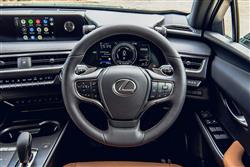Lexus UX 300e - ABC Leasing
E BY HUM(some text hidden)
By Jonathan Crouch
Ten Second Review word count: 101
From launch in 2020, the first Lexus EV, the UX 300e, was hobbled by restricted driving range. But with a new battery offering up to 280 miles between charges, it's now much better placed to reward a thoughtful buyer prepared to think a little more laterally. In the compact SUV segment, there are cheaper full-electric models than this one, some of which still offer greater driving range. But the all-electric driving distance you now get here will probably be sufficient for most suburban users and there are admirably few compromises in terms of interior packaging, plus a very high quality feel.
Background word count: 198
Lexus has been a pioneer in vehicle electrification since introducing the RX 400h in 2005, but back in 2020, this UX 300e model was the brand's very first battery-electric vehicle. It was based on a full-electric version of the Toyota C-HR only offered in China and was the first of a number of production vehicles the brand decided to make under its 'Lexus Electrified' banner. The marque was certainly well placed in create EVs, having built over 1.6 million electrified self-charging hybrids in the last fifteen years. That means breakthrough Lexus technologies like the power control unit, the battery management system and the electric motor have been tried and tested over many millions of miles. The UX300e though, proved to be a bit of a disappointment in its original form, the early 54.3kWh battery only able to take the car 196 miles between charges, a distance easily improved upon by every serious class rival. Things got a bit better though, with an upgrade in early 2023 that brought us the current 72.8kWh version of this Lexus. A model further improved in Autumn 2024 with a few cabin upgrades to create the car we're going to look at here.
Driving Experience word count: 336
This car's change in early 2023 from a 54.3kWh battery to one of 72.8kWh in size didn't increase power: that's still rated at 201bhp. But of course it did a lot for driving range, which rose from the previous feeble 196 mile total to a possible maximum of 279 miles, if your UX300e has 17-inch wheels. With that update, Lexus took the opportunity to incorporate a few engineering changes. These included fine-tuning of the steering and shock absorber settings to sharpen dynamic performance, while additional spot-welding increased body rigidity. These alterations were supposed to improve the car's responsiveness and planted feel, characteristics accentuated by the vehicle's low centre of gravity and the location of the battery pack beneath the floor. Chief Engineer Takashi Watanabe and his team apparently engineered this car with driving fun in mind, building on inherently strong chassis rigidity and redeveloping the standard UX steering and suspension. And sure enough, 300Nm of almost instantly available torque spears you away from rest like a hot hatch, 62mph from rest occupying 7.5s. Under the skin lies a Toyota GA-C platform that's much stiffer than the underpinnings used for the Lexus marque's very first compact model, the CT 200h. To balance the EV powertrain, extra bracing has been added and shock absorber damping has been optimised to better match the specific dynamics and extra weight of a full-electric vehicle. Even so, this Lexus still struggles to transmit all its torque to tarmac quite as quickly as sometimes you might like, the steering feel remains a bit vague and ride quality over poorer surfaces in models fitted with the larger 18-inch wheel rims isn't quite as smooth as we'd ideally like. What is impressive is refinement, further enhanced in this updated model. The engineers have made sure that the thickness and weight of the battery pack beneath the cabin floor will act as a sound-insulating barrier. And they've installed undercovers and wing liners to reduce the noise generated by small stones, dirt, water and the road surface.
Pictures (High res disabled)
.jpg)
.jpg)
.jpg)
.jpg)
.jpg)
.jpg)

.jpg)
.jpg)
.jpg)

Scoring
Category: Compact Car
| Performance | |
| Handling | |
| Comfort | |
| Space | |
| Styling | |
| Build | |
| Value | |
| Equipment | |
| Economy | 60% |
| Depreciation | 60% |
| Insurance | 70% |
| Total | 68% |